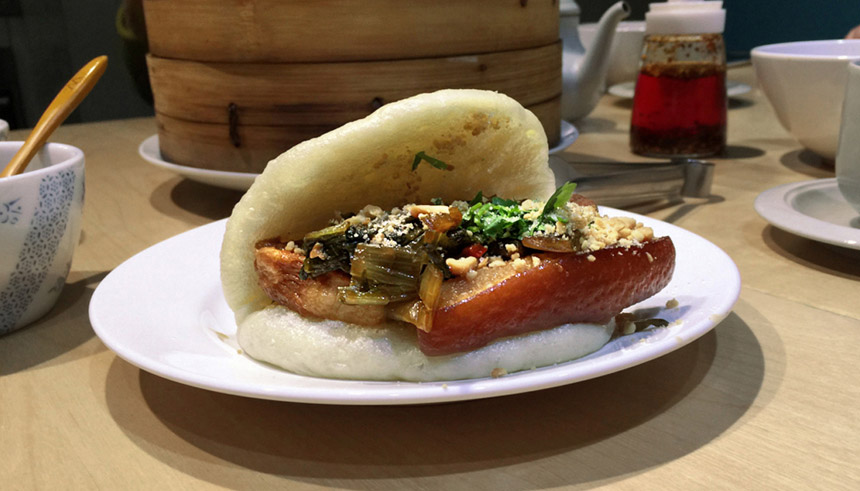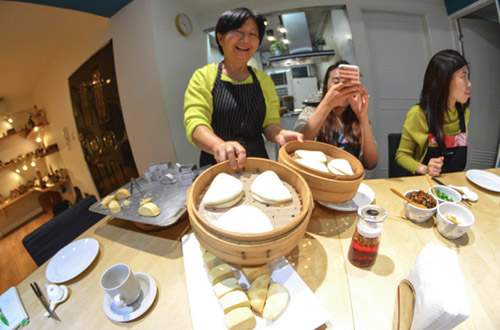East West Lifestyle
Recipes of China: Gua Bao, Taiwan’s Answer to the Hamburger
By Clarissa Wei

First stop in Food Blogger Clarissa Wei’s recipe collecting trip: a Taipei cooking school.
Gua bao, which translates as “cut bun,” is one of the few Taiwanese specialties that haves made it into the American culinary consciousness. It’s hard not to love. The delicacy reportedly has its roots in Fujian, but really, it’s a dish most commonly associated with Taiwan. Gua bao is essentially a hamburger — a steamed white bun that encloses a fatty pork belly garnished with the traditional accoutrements of pickled mustard greens, peanuts dusted with sugar and cilantro. It’s a festival dish, loved predominantly by the Northern Taiwanese and eaten heavily during the Weiya Festival at the end of the year.
“It is also known as ‘tiger bites pig,’” says Ivy Chen (http://kitchenivy.com/), a cooking teacher and cookbook author based in Taipei. “The bun looks like a tiger’s mouth.”
I attended one of Chen’s marvelous cooking classes in Taiwan, where she gave me her personal recipe for gua bao. Chen’s in-house bread maker helped cut down on the kneading time, and it was surprisingly simple to cobble together the rest of the dish. Not that Chen needs the shortcut of a bread maker; she has been teaching cooking classes for 17 years and is very capable of making the dough by hand. She operates out of her cozy home kitchen in the Shilin District in Taipei and speaks fluent English and Mandarin.

Taipei is my first stop on my research trip. The choice is, of course, deliberate. After all, this is the country where my family is from. I consider it my second home. I’m spending my days here meeting up with old faces and learning about the food and culture by simply wandering. It’s a bit overwhelming; the options are truly endless.
Taiwan is an island of immigrants and the diversity shines through the food. The cuisine is a wonderful conglomerate of Fujianese classics, sprinkled with regional delicacies from all throughout China. Fujian, a Southeastern province in Mainland China, is where the bulk of Taiwanese people are from. There are a lot of overlapping dishes, but the differences are apparent. For example, oyster omelets in Taiwan have more potato starch than the ones in Fujian. There’s also a subtle Japanese undertone to Taiwanese cuisine. After all, the Japanese occupied Taiwan from 1895 to 1945. And sashimi and hot pots – shabu-shabu-style – are wildly popular in this country.
Given the geography, seafood figures prominently. Dishes, especially if they are of Sichuan or Hunan origin, are mostly less spicy than their mainland counterparts. The Taiwanese, by and large, don’t do well with heavy spice.
Taiwan is also home to some of the world’s best night markets. These alleyways chock full of street food are an everyday affair. To visit Taiwan without at least a stop at one of the evening bazaars is truly a wasted trip. It is in the night markets where the island’s true flavors shine. And of course gua bao can be found nightly at any given market.
Buns are usually standard; it’s the fillings that matter. Chen, of course, knows this. Her fillings are fantastic. The pork belly is sufficiently tender; the key is to choose a really fat slice at the market. She gently fries her pickled mustard greens to add layers of flavor and the crushed peanuts are sprinkled with sugar for a bit of sweetness. And for the novice cook: rest assured, the bun isn’t that complicated to make. It just takes a bit of patience. Chen says that the same dough can be used to make mantou or fluffy steamed buns. Also of note: the pork belly can be repurposed into stewed pork belly over rice.
Here’s the recipe:
Gua Bao
Servings: 8
Ingredients:For the buns:
- 2 cups (300g) all-purpose flour, sifted
- 1/2 tablespoon dry yeast
- 1 tablespoon sugar
- Pinch of salt
- 2/3 cup (150 mL) lukewarm water
- 1 tablespoon vegetable oil
- 1 stick of cinnamon
For the braised pork belly:
- 1 pound (600g) pork belly, sliced at 1/2 inch
- 1/3 cup soy sauce
- 2 tablespoons rice wine
- 1 1/2 tablespoons sugar
- 3 cups water
- 2 piece star anise or dried orange skin
For the pickled mustard:
- 1 stalk of pickled mustard plant, finely chopped
- 2 tablespoons vegetable oil
- 2 cloves of garlic, finely chopped
- 2 tablespoons soy sauce
- 1 tablespoon sugar
- 1 whole chili, chopped
- 1 1/2 cups crushed peanuts with sugar
- 2 stalks cilantro, chopped
- Soak dry yeast in lukewarm water for 10 minutes.
- Mix sugar and salt with flour and make an impression in the center.
- Add yeast and water mixture, and oil, into the dent. Fold flour into the liquid mixture and knead the dough until smooth. Cover with a damp cloth and allow it to rise to double its size. (This will take anywhere from 40 minutes to two hours, depending on the temperature.)
- Meanwhile, blanch the pork belly in enough boiling water to cover for five minutes. Remove and wash with cold water. This gets rid of debris and extra blood.
- Put the pork in a large pot and add 1/3 cup soy sauce, rice wine, sugar, 3 cups water, star anise (or dried orange skin) and cinnamon. Turn to high heat. The water should cover the pork. If not, simply add more water. Once mixture boils, turn the heat down to low and simmer for 40 minutes.
- In a wok, heat two tablespoons of oil and sauté with garlic. Add pickled mustard plant, soy sauce and sugar. A little water can be sprinkled on top if this is too dry. Stir-fry for eight to 10 minutes over medium low heat, adding in the chili at the end. Set aside.
- After the dough is ready, divide into eight pieces. Knead and shape them into smooth balls.
- Roll each ball into a long oval shape, brush oil on it and fold it in half crosswise. Place on steamer baskets.
- In a steamer pot, preheat water to about 95°F and turn the heat off. Place steamer baskets over the heated pot and let the buns rise for 30 to 40 minutes.
- Bring water to a boil in the steamer pot, steam buns for 12 minutes over medium high heat. Start counting the 12 minutes once steam begins to protrude out of the baskets.
- Turn the heat off and don’t open the steamer basket for another five to six minutes. Cool air will depress and shrink the buns. Lift the lid slowly so the buns don’t shrink.
- Stuff pork, pickled mustard greens mixture, peanut powder and cilantro in the bun. Serve.
Sign up for the Reach Further Newsletter
We’ll keep you in the know about the latest US-Asia business news and trends.
Suscríbase al boletín Reach Further
Lo mantendremos informado sobre las últimas noticias y tendencias comerciales entre Estados Unidos y China.

